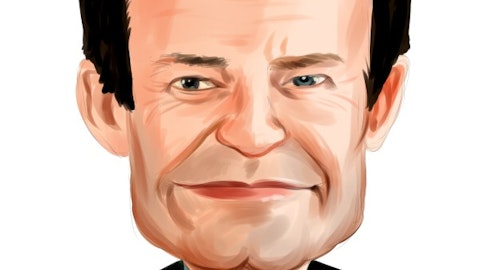And of course, all of this does include the pricing increases that you had mentioned where we’ve added more value. I do want to just stress, because I know there’s a lot of attention on the pricing impact that we always have seen and continue to believe that the primary growth driver for ARR will be new subscriptions in ’24. So, that’s why we’re so focused on the top-of-funnel and new customer acquisition. But specific to your question on pricing, you need to consider a few things. First, our recently announced pricing changes will impact less than half the Creative Cloud base. So there was a very specific question you asked, hopefully, that gives you the answer, but it also leaves us the opportunity to price in new value in the years ahead as we move forward.
Second, the impact will be more visible in net new ARR in the back half of FY ’24 as we lap the previous pricing actions that I was talking to Keith about from last year. And as we roll out the pricing over the next few quarters. So the second half of FY ’24 we’ll see more visibility into the benefits of that to net new ARR. Third, given that we’re rolling out these prices across plans and across geos incrementally over the year, the benefit to ARR will actually be spread across FY ’24 and FY ’25. And fourth, if you really want to have sort of sharpen your pencil, the pricing impact on ARR in ’24 is actually lower than the pricing impact was in ’23 to Creative Cloud. So hopefully that gives you a sense, but again it comes back to this is why we’re so excited about the momentum we’re seeing in new subscriptions, which really bodes well for the business this year and in the long term.
Hopefully, that gives you a pretty good sense on that. And then really quickly on Document Cloud, we’re thrilled with the performance of Document Cloud, a lot of that comes down to our core strategy which has been around integrating the desktop, the web, and mobile into a single ecosystem. And really driving the monthly active usage of Document Cloud up through all of the product-led growth motions we have and converting people on the back-end of that. What we’re really excited about as we bring the AI assistant to market, which by the way, as I mentioned, is now in private beta, expect it to come out in the next few months as a public beta and then, GA later in the year. But what we’re really excited about there is being able to not just service that paid Acrobat based with that, but also start to bring that to the free reader base.
So, lots of opportunity and excitement for the year ahead for Doc Cloud as well.
Alex Zukin: Perfect. Thank you for the very fine point and answer.
David Wadhwani: No problem.
Operator: We’ll take our next question from Kirk Materne with Evercore ISI. Please go ahead.
Kirk Materne: Hi. Thanks and congrats on the quarter and happy holidays. David, I guess I’ll go back to you again, in the commentary, you all talked about enterprise strength and specifically up-selling of Firefly and Express in your enterprise customer base. Can you just give us some more, I guess, qualitative color on what those discussions are like, are they lead — is this part of the reason you’re seeing sort of an uptick in new subscriptions in the enterprise, in particular? And then on Express. Can you just talk again about sort of what you’re seeing in terms of leading indicators of that being an enterprise product that can continue to expand into fiscal ’24. Thanks.
David Wadhwani: Yeah. Maybe I’ll start and then Anil can add because does crossover our two businesses. So with Firefly and Express, very excited about the momentum that we continue to see. You heard that we crossed 4.5 billion generations now, so we continue to see really, really strong adoption and usage of it. Partially as a standalone business, but also integrated into our Photoshop and Illustrator and these existing workflows. And we’re starting to see a lot of interest, not just in the context of using it as part of those existing products, but also using it as part of the ecosystem within enterprises. So, we’ve been working with a number of customers to not just enable them with Firefly, which is the predominance of the growth that we’re seeing in Q4 for enterprise adoption but also have a number of pilot customers already engaged around custom model extension, so that they can bring their own assets and their own content into what Firefly generates.
Second, we’re also enabling the ability to expose it through APIs, so they can build it into their existing workflows and third, we of course connecting it in tying it all into Adobe Express, which now also has its own Firefly and additional capabilities like things, so that you can not just sort of create content using Firefly, but then start to assemble it, start to schedule, social posts around it, start to do multi-language translations that — those are all features that are already in there and then create a stakeholder workflow from people working in Photoshop to the marketers that are trying to post externally. So, that’s where things get very interesting and exciting in terms of the connection we have with GenStudio and everything that Anil is doing.
Anil Chakravarthy: Just building on that, GenStudio since we announced it at MAX, we’ve had a tremendous amount of interest both from enterprise customers like Henkel and Pepsi and Verizon, as well as a number of agencies as well. And primarily it goes back to what we discussed at Summit. The demand for content is expected to grow 5x over the next couple of years, and every brand in the world is looking at, hey, how can we speed up the production of quality on brand content, how can we let a number of other people in marketing, other areas of the company create their own content according to the standards — enterprise standards and the combination of what we have in the Digital Experience portfolio like Adobe Experience Manager and assets as well as what we have in the Creative Cloud, especially around Express and Creative Cloud really let’s enterprises, get that kind of agility and the cost-effectiveness of producing content at scale.
So that’s what we’re seeing and we’re seeing a tremendous amount of interest for that.





